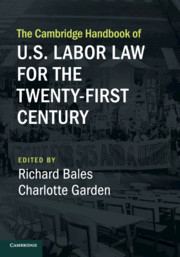Book contents
- Advance Praise for The Cambridge Handbook of U.S. Labor Law for the Twenty-First Century
- The Cambridge Handbook of U.S. Labor Law for the Twenty-First Century
- The Cambridge Handbook of U.S. Labor Law for the Twenty-First Century
- Copyright page
- Contents
- Contributors
- Preface
- Acknowledgments
- Part I Introduction
- Part II Labor Law Is Out of Date
- Part III The “Fissured” Workplace
- Part IV Barriers to Forming a Collective Bargaining Relationship
- Part V Barriers to Bargaining a Good Contract
- 22 Obtaining a First Contract after Winning Recognition
- 23 Advancing Global Labor Standards
- 24 Organizing for Workplace Rights When Immigration Law Discourages It
- 25 The Central Role of the Right to Strike
- 26 Organizational Power for Workers within the Firm
- 27 Returning Members-Only Collective Bargaining to the American Workplace
- Part VI Unions, Civil Society, and Culture
27 - Returning Members-Only Collective Bargaining to the American Workplace
How to Restore Labor’s Countervailing Power
from Part V - Barriers to Bargaining a Good Contract
Published online by Cambridge University Press: 01 November 2019
- Advance Praise for The Cambridge Handbook of U.S. Labor Law for the Twenty-First Century
- The Cambridge Handbook of U.S. Labor Law for the Twenty-First Century
- The Cambridge Handbook of U.S. Labor Law for the Twenty-First Century
- Copyright page
- Contents
- Contributors
- Preface
- Acknowledgments
- Part I Introduction
- Part II Labor Law Is Out of Date
- Part III The “Fissured” Workplace
- Part IV Barriers to Forming a Collective Bargaining Relationship
- Part V Barriers to Bargaining a Good Contract
- 22 Obtaining a First Contract after Winning Recognition
- 23 Advancing Global Labor Standards
- 24 Organizing for Workplace Rights When Immigration Law Discourages It
- 25 The Central Role of the Right to Strike
- 26 Organizational Power for Workers within the Firm
- 27 Returning Members-Only Collective Bargaining to the American Workplace
- Part VI Unions, Civil Society, and Culture
Summary
If the National Labor Relations Act (NLRA or Act) could speak, it would say, as Mark Twain said: “The reports of my death are greatly exaggerated,” or as Joe Hill said in a dream: “I never died says he.” In fact, the NLRA is very much alive – “alive as you and me” – and notwithstanding its naysayers and its many faults, it could go down in history as one of the nation’s most significant statutes, for it has the capacity to provide the platform from which a renewed labor movement could emerge. Although there are other high-sounding proposals which, if implemented, might provide a more equitable means for workers to improve their lot and the lot of the nation as a whole, good ideas aren’t enough. All of those pie-in-the-sky solutions require Congressional approval, which can’t and won’t happen in the foreseeable future. On the other hand, if the National Labor Relations Board (NLRB or Board) were to adopt an available procedure for which no Congressional action is required, the present NLRA, even with its serious shortcomings, could become positively viable. The most promising of those procedures is one that has already proven itself: nonmajority collective bargaining (NMCB) often referred to as “nonmajority” or “minority-union” collective bargaining. This procedure was commonly practiced during the first decade following passage of the Act in 1935, and was belatedly reintroduced in my 2005 book, The Blue Eagle at Work. NMCB allows a union to organize and bargain collectively for its member-employees when they comprise less than a majority in an appropriate bargaining unit, and elections are a rarity rather than a requirement. The Blue Eagle NMCB is now ready to soar, and it could do so as an integral part of a resurgence of the American labor movement, which is now in free-fall.
- Type
- Chapter
- Information
- Publisher: Cambridge University PressPrint publication year: 2019
- 1
- Cited by



